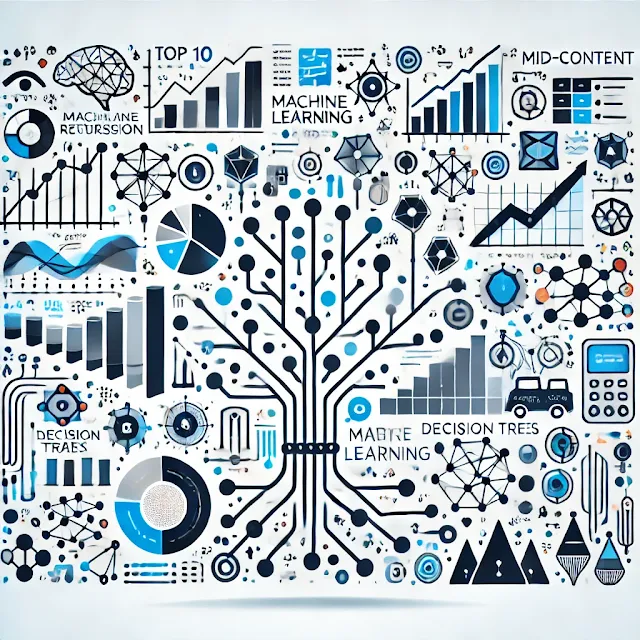Machine learning is leading the technological revolution in all industries, transforming the way companies function in healthcare, finance, transportation, and e-commerce. For any individual pursuing a career in data science, mastering the core machine learning algorithms is crucial.
The algorithms are the backbone of predictive analytics, recommendation systems, natural language processing, and much more.
In this guide, we take you through the top 10 machine learning algorithms that every aspiring data scientist ought to know. Each will be explained in detail, along with how it works, its strengths, key applications, and why it remains relevant even in modern data science practices.
1. Linear Regression
Linear Regression is one of the most basic supervised learning algorithms used to make predictions on continuous numerical targets. It creates a linear relationship between the input features and the target variable.
Mathematical Representation:
Y = β₀ + β₁X₁ + β₂X₂ +. + βnXn + ε,
Where:
Y: the predicted target variable
X₁, X₂,.Xn: the input features
β₀: the intercept, and β₁, β₂,.are coefficients
ε: error term
How it Works:
Linear Regression is a method to find the best-fit line by minimizing the sum of squared errors, that is, by using the least-squares method. It iteratively adjusts the coefficients to minimize the error between actual and predicted values.
Types of Linear Regression
- Simple Linear Regression: Involves one independent variable.
- Multiple Linear Regression: Involves multiple independent variables.
Advantages
- Easy to implement and interpret.
- Provides clear insights into the relationship between variables.
Limitations
- Assumes a linear relationship; performs poorly for nonlinear data.
- Sensitive to outliers, which can skew predictions.
Key Applications Examples:
- House Price Prediction: House price forecasting on the basis of size, location, and features
- Sales Forecasting: Sales prediction for the future with historical data
- Stock Price Trends: Trend analysis for prediction of future stock price
2. Logistic Regression
Logistic Regression is a Supervised Learning Algorithm for a Binary Classification Problem where the output is 0 or 1, Yes/No, or True/False, although its name does not convey that it is indeed a classification algorithm rather than a regression one.
How it works:
Instead of predicting a continuous output, Logistic Regression estimates the probability that a data point belongs to a certain class using the sigmoid function:
P(Y=1) = 1 / (1 + e^(-z)),
where z = β₀ + β₁X₁ +. + βnXn (linear combination of features).
The threshold probability (default is 0.5) determines class labels. For example:
If P ≥ 0.5 → Class 1.
If P < 0.5 → Class 0.
Advantages
- Simple, fast, and effective for binary classification.
- Works well with linearly separable data.
Limitations:
- Assumes a linear relationship between input features and log-odds.
- It is not ideal for highly complex data without modifications.
Key Applications:
- Email Spam Detection: Classifying emails as spam or not.
- Customer Churn Prediction: Predicting whether a customer will leave a subscription.
- Disease Diagnosis: Identifying whether a patient has a disease based on symptoms.
3. Decision Trees
Decision Trees are versatile supervised learning algorithms used for both classification and regression tasks. They use a tree-like structure to make decisions based on input features.
How it Works:
The tree starts with a root node that represents the entire dataset.
At each internal node, the data is split based on a condition (feature threshold) that minimizes impurity (e.g., using Gini Index or Entropy).
It then recursively continues until it encounters a stopping criterion.
The output at the end depends on the leaf nodes
Advantages
- It's easy to understand and also to visualize.
- Handles numeric and categorical data
- Handles nonlinear decision boundaries pretty effectively.
Limitations
- Tends to overfit, especially for deeper trees.
- Sensitive to noisy data
Key Applications:
- Customer Segmentation: It divides the customers based on buying behavior.
- Credit Risk Assessment: Loan eligibility assessment
- Fraud Detection: Patterns of financial transactions and detection of unusual patterns
- Banks use decision trees to approve or deny loan applications based on income, age, and other factors.
4. Support Vector Machines (SVM)
Support Vector Machines are robust supervised learning algorithms used for both classification and regression. SVMs aim to find the optimal hyperplane that best separates classes in a high-dimensional space.
How it Works:
SVM identifies the hyperplane that maximizes the margin between two classes.
For nonlinear data, SVM uses a kernel function (e.g., polynomial, RBF) to transform the data into an even higher dimension where they become linearly separable.
Strengths:
- Effective for high-dimensional data.
- Works well for small-to-medium-sized datasets.
Weaknesses:
- Computationally extensive for large datasets.
- It is very sensitive to the choices of kernel functions.
Key Applications:
- Text Classification - Classifying documents into classes.
- Image Recognition - Finds objects in images.
- Bioinformatics - Protein classification and cancer detection.
5. K-Nearest Neighbors (KNN)
K-Nearest Neighbors is a non-parametric and lazy learning algorithm employed for both classification and regression tasks.
How It Works:
- Calculate the Euclidean distance between the test point and all points in the training data.
- Select the K nearest neighbors.
- Generate the output based on voting for majority cases or average it for regression.
Strengths:
- Easy to implement as well as intuitive
- The explicit training phase is absent.
Weaknesses:
- Compute-intensive, especially when the number of data samples is large.
- Robustness to features with no significance and noisy elements.
Key Applications:
- Recommendation Systems: Product recommendation based on similarity in user behavior.
- Anomaly Detection: Detection of outliers from data.
- Medical Diagnosis: Classification of diseases from the patient's data.
6. Naïve Bayes
Naïve Bayes is a probabilistic classification algorithm that follows Bayes' Theorem. It assumes independence of features, which simplifies computations.
Formula:
P(Class|Features) = [P(Features|Class) * P(Class)] / P(Features).
Strengths:
- Fast and efficient for high-dimensional data.
- Works well for text-based data.
Weaknesses:
- Naïve Bayes assumes that all features are independent of each other. In real-world scenarios, this assumption often does not hold, as many features are correlated
- If a categorical variable in the test dataset has a category that was not seen in the training dataset, Naïve Bayes assigns a zero probability to that outcome, effectively ignoring it.
Key Applications:
- Spam Filtering.
- Sentiment Analysis.
7. K-Means Clustering
K-Means is an unsupervised machine learning algorithm used for clustering tasks, where data is grouped into K distinct, non-overlapping clusters. It minimizes the intra-cluster variance to form groups with maximum similarity.
How it Works:
- Choose the number of clusters (K).
- Initialize K centroids randomly.
- Assign each data point to the nearest centroid using a distance measure (e.g., Euclidean distance).
- Update centroids by computing the mean of the points within each cluster.
- Repeat steps 3 and 4 until the centroids stabilize or a stopping condition is met.
Advantages:
- Easy and scalable with big data.
- It performs well when clusters are spherical and of equal size.
Drawbacks:
- Need to define the number of clusters, K.
- Sensitive to initial centroids and outliers.
Key Applications:
- Customer Segmentation: Clustering customers according to their purchase behaviors for targeted marketing
- Market Basket Analysis: Products are often purchased together.
- Anomaly Detection: Finding patterns that deviate from regular patterns in network traffic or financial transactions.
Real-Life Application:
E-commerce sites such as Amazon use K-Means to cluster customers based on behavior, like purchase history, browsing patterns, and spending habits.
8. Principal Component Analysis (PCA)
PCA is a technique of dimensionality reduction. It reduces the number of features and retains maximum variance in the data. PCA is an unsupervised algorithm often used in pre-processing high-dimensional data.
How it Works:
- Standardize the data with mean = 0 and variance = 1.
- Compute the covariance matrix to identify the relationships between the features.
- Calculate the eigenvectors and eigenvalues of the covariance matrix.
- Sort the eigenvectors according to their eigenvalues from largest to smallest.
- Select the top K eigenvectors (principal components) and project the data onto this reduced feature space.
Advantages:
- It reduces the computational cost because the data is simplified.
- The models with many features do not risk overfitting.
Disadvantages:
- The variables are assumed to be linearly related in PCA.
- The interpretability of the features is lost when they are reduced.
Key Applications:
- Image Compression: Dimensionality reduction of image data without compromising the quality.
- Data Visualization: Projection of high-dimensional data into 2D or 3D for visualization.
- Feature Extraction: Eliminating any redundant feature to enhance model performance.
Real World:
PCA is used in a majority of facial recognition-based systems where facial features need to be compressed to analyze them quickly and efficiently.
9. Random Forest
Random Forest is one form of ensemble learning; the predictive ability of decision trees improves, and it is also an ability to not overfit while building several decision trees to obtain results.
The final output is determined through majority voting (classification) or averaging (regression).
Strengths:
- Handles both classification and regression effectively.
- Robust to overfitting as it uses ensemble averaging.
- It operates well with huge datasets and high-dimensional data.
Limitations:
- It is too computationally expensive if very large datasets are being analyzed.
- Interpretation will be reduced compared to one decision tree.
Key Applications:
- Fraud Detection: Identifying the transaction as fraudulent in a system of finance.
- Medical Diagnostics: Predicting diseases through analysis of medical records.
- Predictive Analytics: Demand or Sales or Trend prediction
- Healthcare providers use Random Forest to diagnose diseases like diabetes and cancer by analyzing complex patient data.
10. Gradient Boosting Machines (GBM)
Gradient Boosting Machines (GBM) are powerful ensemble methods that build models sequentially, where each new model reduces the errors made by the previous one. Unlike Random Forest, GBM focuses on reducing prediction residuals step by step.
How it Works:
- A weak learner, such as a shallow decision tree, is learned from the available data.
- Residuals, or errors, are generated as the difference between the prediction and actual outputs.
- A new model has been learned that predicts errors.
- The results of all predictors are summed together to optimize the error.
- This now repeats indefinitely until some condition for termination is met
- Popular Implementations:
- CatBoost: Built for categorical data without heavy preprocessing.
Advantages:
- High accuracy in prediction.
- Both structured and unstructured data can be used.
- GBM is widely used in machine learning competitions.
Disadvantages:
- Hyperparameter tuning has to be done carefully so that overfitting doesn't occur.
- It's computationally expensive for large datasets.
Key Applications:
- Ranking Systems: GBM is used by Google search engines to rank web pages.
- Customer Propensity Modeling: Predicting the propensity of a customer to take specific actions.
- High Accuracy Predictions: Weather forecasting, stock price predictions, and many more.
Real-World Example:
XGBoost is widely used in Kaggle competitions for its ability to deliver superior performance with well-tuned hyperparameters.
Conclusion
The machine learning algorithms discussed here—ranging from simple models like Linear Regression to advanced ensemble techniques like Gradient Boosting Machines—are the building blocks of modern data science.
Each algorithm serves specific purposes, addressing diverse problems like classification, regression, clustering, and dimensionality reduction.
Understanding how these algorithms work, their strengths and their limitations will empower aspiring data scientists to select the right tools for solving real-world challenges.
As you progress in your machine learning journey, experimenting with these algorithms on datasets, tuning hyperparameters, and combining techniques will help you gain hands-on expertise and deeper insights into their practical applications.
By mastering these basic concepts, you will be well-positioned to tackle advanced topics such as deep learning, reinforcement learning, and real-world AI systems and will be well-equipped to contribute meaningfully to the ever-evolving field of data science.


